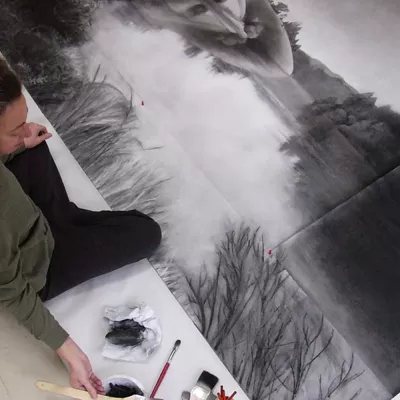The Limited Palette: A Good Place to Start
Instruction Media: Oil Paint
How a painting is begun is crucial to how the painting process will unfold. In this 5-week course we explore two di?erent ways of beginning to paint in oils using two di?erent limited palettes:
1. The Primary Prismatic Palette: Inspiration comes from the Pointillist paintings of Neo- Impressionist painter Georges Seurat. We mix a full range of colors from red, yellow, blue, and white. Avoiding the use of lines, we apply the paint as dots (or any gestural brushstroke that is not a line) to experience how paint itself creates the illusion of three- dimensions, light, and space.
2. The Earth Palette: Using classical techniques, we make a painting in three layers. On the first day we begin with a transparent monochromatic underpainting for establishing values from light to dark. On the second day, we use earth colors plus white for suggesting hues and warm/cool relationships. On the third day, we complete the painting using a full palette with transparent glazing, translucent Velatura, opaque, and impasto paint applications.
We practice loading the lights to make the image pop, and we contrast that with painting the darkest darks transparently. We organize our palettes as a series of gradations of mixed hues and tints that facilitate the painting process and ensure that our colors will be harmonious. Each class begins with a painting demonstration, and we look at art historical references and other visually inspiring materials that explain the hows and whys of each lesson. We paint from simple still life set-ups.
The skills practiced in this class will equip students for future painting classes and for moving forward towards developing their own individual methods and vision.
Required Supplies
A variety of brushes, including the following:
bristle round size 2 A must for the first day of class.
bristle filberts and/or bristle flats sizes 4, 6
bristle bright size 2 economy
White Bristle Brush size 2-inch* These are sold as inexpensive gesso brushes at Blick https://www.dickblick.com/items/blick-economy-white-bristle-brush-gesso-2/
SOLVENT
Solvent in a small jar for cleaning brushes and also for mixing painting mediums (see recipes below)
odorless mineral spirits (Gamblin Gamsol). Note: Turpentine is not allowed at Gage Academy.
SOAP
plain white bar soap such as Ivory
OIL
linseed oil (refined)
PALETTE
We will be mixing gradations of colors so a bigger palette is better than a small one.
paper or wood or plexiglass recommended paper palette available at Blick: https://www.dickblick.com/items/blick-palette-paper-pad-12-x-16-50-sheets/
PALETTE/PAINTING KNIFE
For this class the best shape is: “Painting Knife - Small Long Spade 50” https://www.dickblick.com/items/blick-painting-knife-58-x-2-78-traditional-style-50-/
PAPER TOWELS
We use these as a painting tool as well as for cleaning up. Bounty brand paper towels are best.
OIL PAINTS
Best brands are Gamblin, Old Holland, Williamsburg, Rembrandt
Prismatic colors
quinacridone red
cadmium yellow medium
ultramarine blue (note: not a phthalocyanine blue)
Earth colors
earth red such as Old Holland red ochre or Williamsburg “Italian Rosso Veneto” (note not Venetian red unless it is Williamsburg Italian Rosso Veneto)
yellow ochre (PY 43): Old Holland yellow ochre light is best
ivory black
White
titanium white or titanium zinc white
PAINTING MEDIUMS
In a small glass jar or eyedropper bottle mix odorless mineral spirits and refined linseed oil for each day as follows:
Day one—2 parts odorless mineral spirits plus 1 part refined linseed oil
Day two—refined linseed oil
Day three—2 parts odorless mineral spirits plus 1 part refined linseed oil
Day four—1 part odorless mineral spirits plus 1 part refined linseed oil
Day five—refined linseed oil
WHAT TO PAINT ON?
Not smaller than 9 x 12 inches. Here are a few options:
stretched and primed canvas
gessoed panel
Fredrix canvas pad (these are not sold at Blick in Seattle, but they can be ordered online. This brand is superior to Blick canvas pads)
gessoed mat board,
museum board, or heavyweight hot pressed watercolor paper—Use a minimum of 3 coats of Golden white acrylic gesso. Change the direction of the brushstrokes for each layer. Note: Painting in oils on an acrylic gesso priming is perfectly sound, as long as the gesso has had time to cure and is completely dry. Overnight is a sufficient amount of drying time.
MISCELLANEOUS
Nitrile gloves for protecting skin from pigments and solvent, highly recommended.
We will make a small sketch with pen or pencil on paper on the 3rd day of class.
ON THE FIRST DAY OF CLASS… From the above list, the only these supplies are needed:
brushes—bristle rounds size 2
a jar of odorless mineral spirits for cleaning brushes
a bar of soap
a small jar or eye dropper bottle of medium—2 parts odorless mineral spirits plus 1 part refined linseed oil
palette
palette/painting knife
paper towels
oil paints—ultramarine blue and titanium or titanium zinc white
a surface upon which to paint
Kits for The Limited Palette: A Good Place to Start are available at Blick Capitol Hill. Just stop by the store to purchase/pick up in person. A QR code allows students to purchase the kit online and then visit the store to pick it up will also be available. Basically that is an advanced purchase, buy online/ pick up in store option.
$149.99 total price for each kit is a significant savings over purchasing each item individually. Each kit contains:
Titanium white, Gamblin 37 ml.
Ivory black, Gamblin 37 ml.
Yellow ochre light, Old Holland 40 ml.
Red ochre, Old Holland 40 ml.
Ultramarine blue, Gamblin 37 ml.
Cadmium yellow medium, Gamblin 37 ml.








